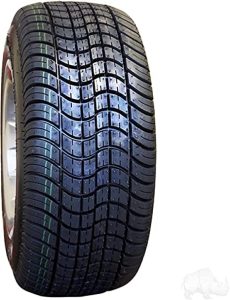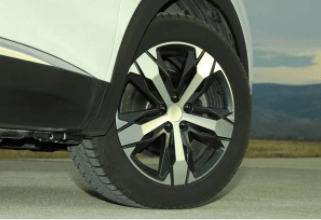Table of Contents
What Are Low Profile Tires?
Low-profile tires: are tires with low aspect ratios and shorter sidewalls. You have a low-profile tire for any reading of about 55% or less.
For instance, if you have a reading of 205/55 R16 on your tire sidewalls, the 55 is an indication of a 55% aspect ratio and height, while the R is an indication of a rim size of 16.
Low-profile tires are well-known for the sportier look it has on vehicles since it helps vehicles to have better CG (center of gravity) and more efficient braking and grip on the road. That doesn’t mean that low-profile tires are solely used in the sporting industry, but it was first a trend in the sporting industry before being adopted as a standard in some vehicles.

Characteristics Of Low-profile Tires
Some characteristics are responsible for why tires are classified as low-profiles or otherwise. Let’s quickly go through this characteristic in detail.
1). Low Profile Tires And The Rates Of Wear And Tear: Low profile tires are so designed with a low aspect ratio and shorter sidewalls, indicating they’ve greater width than regular tires since they’re designed with greater width, which is a quick indication for more tire tread and a determinant of how fast and enhanced their grip with the road surfaces is.
While this feature could be considered advantageous, it also signifies that low-profile tires are prone to more wear and tear compared to other tires like regular tires. That said, if you’re using a low-profile tire, you will have to change your tire more frequently than other tires.
2). Low Profile Tires And Suspension System: Tires are part of vehicle suspension systems. That means the type of tire used is among the factors influencing the car suspension; how the car will respond when you hit a speed bump, corner, and steps on the brake.
Low-profile tires afford a vehicle with more cushioning effects when you hit a speed bump since it has better damping effects. But when a car comes suddenly or over-sped into a pothole,
such a car’s suspension systems won’t react/respond appropriately as designed and intended by the manufacturer. We should drive civil and responsible, as tires’ specifications don’t offer immunity against the adverse effects of violating road users’ safety rules.
3). Low-Profile Tires and Pressure: The best advice is to stick to the manufacturer’s guide for the pressure a vehicle should operate on. This guide should be strictly stuck with, especially during your routine check.
Running tires under or over flat may negatively influence your fuel economy, tire blowout, or overheating.
Just a reminder, always stick with the guidelines in your manufacturer’s handbook for maximum safety.
4). Low Profile Tires And Installation/Mounting: If you so desire to maneuver/change your vehicle’s tires to low profile tires, then you’ve to reconfigure your vehicle’s suspension system, which includes changing your tire rim to that of low profile rim to avoid a case of misfits and discomfort to your vehicles proper functioning.
Advantages And Disadvantages Of Low-Profile Tires
1). Improved look: Low profile tires give vehicles a sportier look and better aesthetics compared to other tires like regular tires.
When low-profile tires are mounted on the vehicle’s wheel, it brings about a reduction in height, as well as improved aesthetic feelings.
2). Higher Stability: When vehicles become low, it brings about an improved center of gravity and partly eradicates the chances of unnecessary skidding. Improved stability also brings about a smoother driving experience.
3). Better Grip: Low profile tires have an improved and more treading, which brings about better grip with road surfaces when barking curves/cornering and braking.
Disadvantages
1). More Wear And Tear: More treads made with soft compounds result in more wear and tear on low-profile tires.
2). More prone To Damage: Low profile tires lower vehicles, which means that the engine parts like the sump have also come lower. If you’re driving on a rough road with potholes and hill paths or you incidentally ran into a bump — you might get your engine’s sump damage and some other parts.
3). Poor Grips On Irregular Surfaces: Low-profile tires are made with a soft compound that results in poor grips with irregular road surfaces like snowy paths.
This is a significant setback to the use of low-profile tires when compared to regular tires.
4). Poor fuel economy: Another adverse use of low-profile tires is poor fuel economy. And it’s advisable that if you’re a car owner that is mileage conscious, you may have to rethink or make a budget for using low-profile tires.
Are low-profile tires bad in the rain?
Low-profile tires are excellent for rainy times compared to regular tires due to their more
expansive surfaces, which ensures that we have more treaded area coming in contact with road
surfaces.
One should quickly revisit the knowledge acquired in physics class to answer the question of
whether low-profile tires are wrong in the rain.
According to the conditions for friction, the nature of surfaces in contact affects their sliding motions, in this case, tire on a wet floor due to rain.
And remember, low-profile tires are known to have more expansive surfaces compared to regular, which comes in handy in ensuring better grip with road surfaces.
Since the broader surfaces are an indication that we’ve more treaded surfaces in contact with the road, which helps increase traction on the road and reduce the rolling resistance.
So simply put, low-profile tires are in no way terrible in the rain. Instead, its designs made it to be better suited for wet surfaces.
How long do low-profile tires last?
According to most manufacturers, low-profile tires can last over 50,000 miles before users think
of a replacement.
While this answer might seem satisfactory, there might be more to consider, especially at individual levels and the road conditions to which this tire will be subjected.
No doubt 50,000 miles, about 80,000 kilometers, is a great distance that might take average users about 3 years to cover. But let’s briefly look at other factors:
- Speed: If you’re a road user who drives more in James Bond’s fashion, corners, and steps on
brakes too fast and suddenly, then your tires have the likelihood of wearing out unusually faster
compared to your neighbor who drives more civil. - Road conditions: If the path you pass is always rough terrain or sloppy hills, you shouldn’t
expect your tires to wear out like that of a friend who drives on a well-tared road. - Road hazard: Hazards like potholes, stepping on objects like nails, and accidents would
negatively affect your tire’s lifespan and may cause them to wear out faster than usual.

